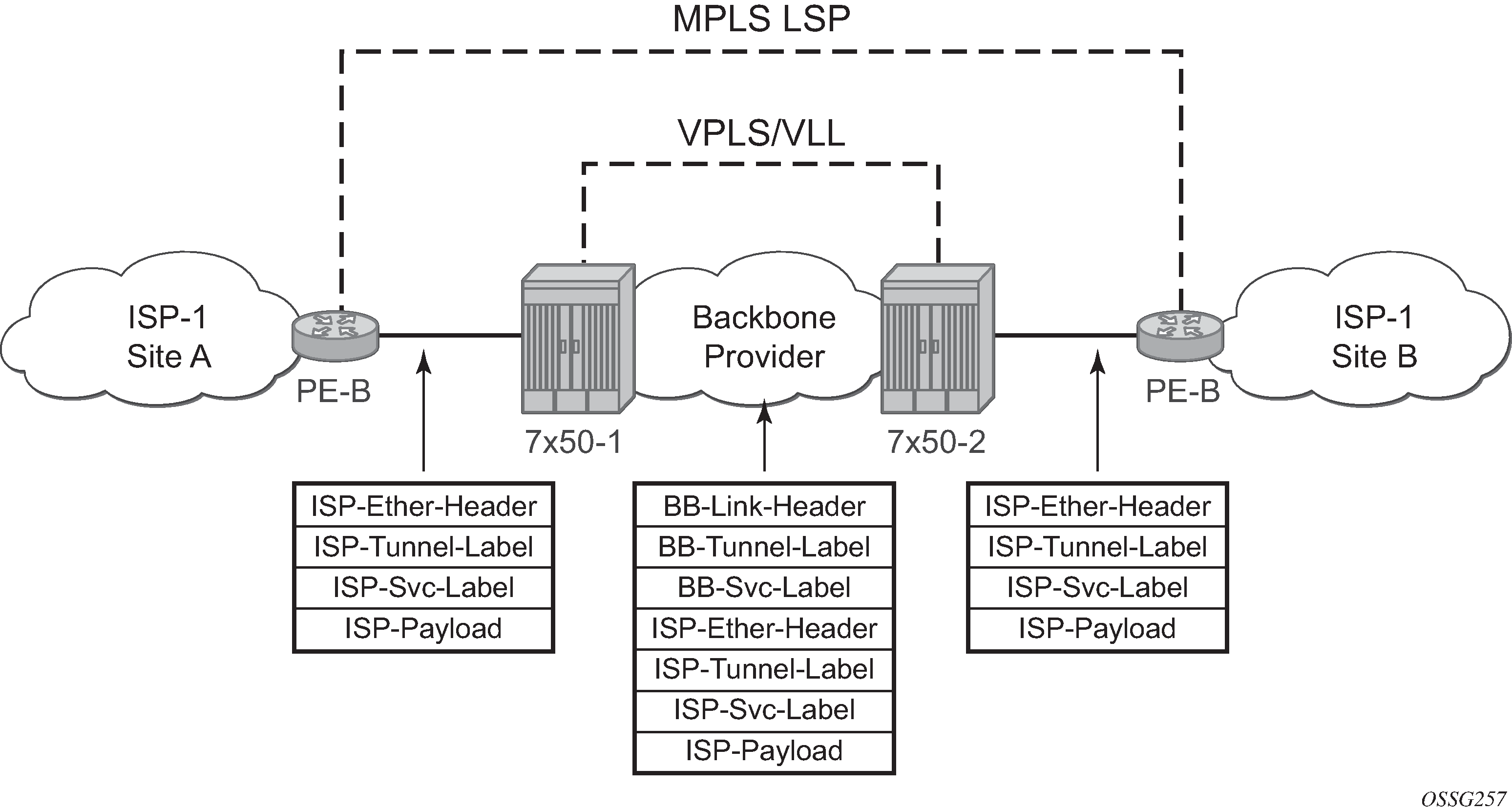To accommodate backbone ISPs who want to provide VPLS/VLL to small ISPs as a site-to-site inter-connection service, small ISP routers can connect to Ethernet Layer 2 SAPs. The traffic is encapsulated in a VLL/VPLS SDP. These small ISP routers are typically PE routers. To provide appropriate QoS, the routers support a new classification option that based on received MPLS EXP bits. Figure: Example configuration — carrier application shows a sample configuration.

The lsp-exp command is supported in sap-ingress qos policy. This option can only be applied on Ethernet Layer 2 SAPs.
Table: Forwarding class classification based on rule type lists forwarding class behavior by rule type.
| # | Rule | Forwarding class | Comments |
|---|---|---|---|
1 |
default-fc |
Set the policy’s default forwarding class. |
All packets match the default rule. |
2 |
IP criteria:
|
Set when an fc-name exists in the entry’s action. Otherwise, preserve from the previous match. |
When IP criteria is specified, entries are matched based on ascending order until first match, then processing stops. A packet can only match a single IP criteria entry. |
3 |
MAC criteria:
|
Set when an fc-name exists in the entry’s action. Otherwise, preserve from the previous match. |
When MAC criteria is specified, entries are matched based on ascending order until first match, then processing stops. A packet can only match a single MAC criteria entry. |
The enqueuing priority is specified as part of the classification rule and is set to ‟high” or ‟low”. The enqueuing priority relates to the forwarding class queue’s low drop tail where only packets with a high enqueuing priority are accepted into the queue when the queue’s depth reaches the defined threshold. See Queue drop tails.
The mapping of IEEE 802.1p bits, IP Precedence, and DSCP values to forwarding classes is optional as is specifying IP and MAC criteria.
The IP and MAC match criteria can be very basic or quite detailed. IP and MAC match criteria are constructed from policy entries. An entry is identified by a unique, numerical entry ID. A single entry cannot contain more than one match value for each match criteria. Each match entry has a queuing action that specifies:
the forwarding class of packets that match the entry
the enqueuing priority (high or low) for matching packets
The entries are evaluated in numerical order based on the entry ID from the lowest to highest ID value. The first entry that matches all match criteria has its action performed.
The supported service ingress QoS policy IP match criteria are:
destination IP address/prefix
destination port/range
IP fragment
protocol type (TCP, UDP, and so on)
source port/range
source IP address/prefix
DSCP value
The supported service ingress QoS policy MAC match criteria are:
IEEE 802.2 LLC SSAP value/mask
IEEE 802.2 LLC DSAP value/mask
IEEE 802.3 LLC SNAP OUI zero or non-zero value
IEEE 802.3 LLC SNAP PID value
IEEE 802.1p value/mask
source MAC address/mask
destination MAC address/mask
EtherType value
Table: MAC match Ethernet frame types describes the frame format on which the MAC match criteria that can be used for an Ethernet frame depends on.
| Frame format | Description |
|---|---|
802dot3 |
IEEE 802.3 Ethernet frame. Only the source MAC, destination MAC, and IEEE 802.1p value are compared for match criteria. |
802dot2-llc |
IEEE 802.3 Ethernet frame with an 802.2 LLC header. |
802dot2-snap |
IEEE 802.2 Ethernet frame with 802.2 SNAP header. |
ethernet-II |
Ethernet type II frame where the 802.3 length field is used as an Ethernet type (Etype) value. Etype values are 2-byte values greater than 0x5FF (1535 decimal). |
The 802dot3 frame format matches across all Ethernet frame formats where only the source MAC, destination MAC, and IEEE 802.1p value are compared. The other Ethernet frame types match those field values in addition to fields specific to the frame format. Table: MAC match criteria frame type dependencies lists the criteria that can be matched for the various MAC frame types.
| Frame format | Source MAC | Dest MAC | IEEE 802.1p value | Etype value | LLC header SSAP/DSAP value/mask | SNAP-OUI zero/non-zero value | SNAP- PID value |
|---|---|---|---|---|---|---|---|
802dot3 |
Yes |
Yes |
Yes |
No |
No |
No |
No |
802dot2-llc |
Yes |
Yes |
Yes |
No |
Yes |
No |
No |
802dot2-snap |
Yes |
Yes |
Yes |
No |
No1 |
Yes |
Yes |
ethernet-II |
Yes |
Yes |
Yes |
Yes |
No |
No |
No |
Service ingress QoS policy ID 1 is reserved for the default service ingress policy. The default policy cannot be deleted or changed.
The default service ingress policy is implicitly applied to all SAPs that do not explicitly have another service ingress policy assigned. Table: Default service ingress policy ID 1 definition lists the characteristics of the default policy.
| Characteristic | Item | Definition |
|---|---|---|
Queues |
Queue 1 |
One queue for all unicast traffic:
|
Queue 11 |
One queue for all multipoint traffic:
|
|
Flows |
Default Forwarding Class |
One flow defined for all traffic:
|